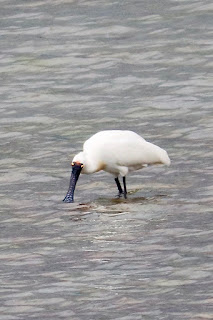The Otago Peninsula is home to a large number of unique and endangered species, many of which we saw on our tour with David from Elm Wildlife Tours. He is a Ph.D. candidate in marine biology and was an outstanding guide. Not only did he know a huge amount of information about the biology and behavior of the animals we saw, he could also spot the smallest indication of an animal’s presence. This little owl juvenile, for instance, is only 23 centimetres (9 inches) tall but David spotted it from across the road hiding in the crook of a tree.
We spent seven hours on the peninsula, which is part of a crater wall formed by an ancient volcano. It’s pretty astonishing to find such a wild place filled with unique animals only 30 kilometers (19 miles) from the bustling city of Dunedin.
Royal Spoonbill (the spoon shaped part of its bill is under water)
White-faced Heron
One native bird, the red-billed gull, used to be abundant across New Zealand but it is currently endangered due to ocean warming. These gulls feed mostly on krill but higher ocean temperatures are driving the krill deeper into colder water where the gulls can’t reach them. The entire species is in decline but the population on the Otago Peninsula is still stable (perhaps due to its proximity to colder arctic waters). There was a large (and noisy) nesting colony near the tip of the peninsula.
Red-billed Gull Chick
The royal albatross breeds on only one mainland in the world, the Otago Peninsula. It is breeding season so we got to see these magnificent birds on the nest. With a wingspan of 3 metres (9 feet 6 inches), the royal albatross is the largest seabird. Albatrosses spend much of their lives at sea and tracking research has shown that they often circumnavigate the antarctic during their months in flight.
Albatross breed every other year, laying a single egg. This process takes up to 12 months from nest building to chick fledging. The population of royal albatross is still considered vulnerable but has had a healthy recovery from a serious decline at the end of the 19th and early 20th centuries.
We also saw variable oystercatchers, an endemic species (found only in New Zealand), on the nest, which is simply a shallow scrape in the sand, often surrounded by seaweed or driftwood. This species’ population is considered stable.









No comments:
Post a Comment